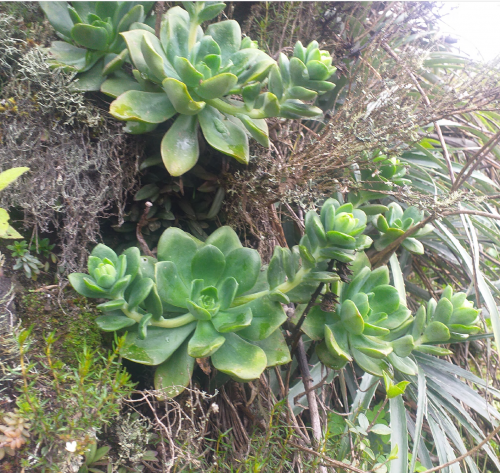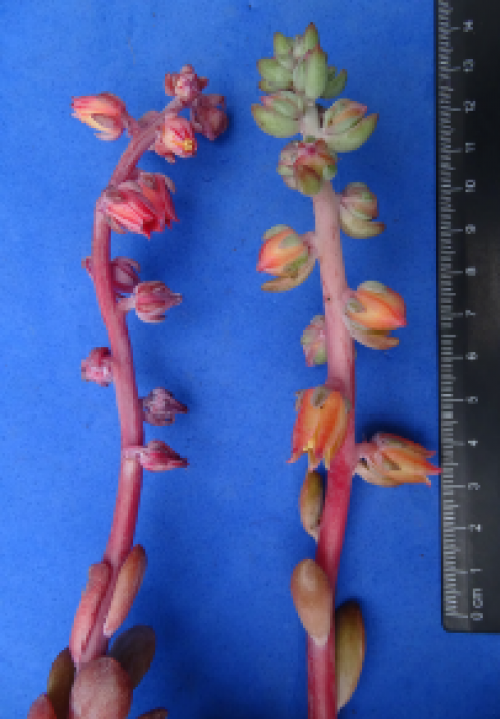INCAICA Pino, Alcalá & Marquiegui, 2021
Series Racemosae
Type : Peru, dept. Huancavelica, prov. Tayacaja, distr. San Marcos de Rocchac, Pino, Alcalá & Marquiegui 3276, 3076 m, Jan 22, 2021.
Etymology : The name refers to the Inca Empire that ruled Peru before the Spaniards.
Distribution : Peru (dept. Huancavelica, prov. Tayacaja, distr. of San Marcos de Rocchac) probably also in neighbouring districts in dept. Junin.
Description :
A succulent glabrous, solitary herb.
Stem, conspicuous, thick, erect or rarely shortly decumbent at base, greyish-green to brownish, 3–15 (–45) cm long, (0.8–) 1.2–1.6 (–2.2) cm diam., terete or slightly irregular due to oval, somewhat projected 0.3 x 0.4 leaf scars every 0.8–1 cm.
Rosettes terminal, simple, (7–) 12–15 (–18) cm diam.
Leaves sessile, in young plants 7-10, ovate, acute in mature plants (10–) 13–25, spirally arranged, obovate in central leaves, orbicular to subspatulate in peripheral ones, narrowly obovate in very large plants, 4.5–9 cm long, 0.5–0.8 cm wide at base, 0.8–1.4 cm wide at proximal third, 2–3 cm wide at middle, 2–2.8 wide at distal third, 0.6–1 cm thick, apex subobtuse (acute in very large leaves), with a 1 x 2 mm recurved mucro, margins smooth; upper side slightly concave to canaliculate, central nerve depressed, dark green to yellowish green, brownish red near margins, central leaves somewhat purplish; lower side subcarinate near apex, light green or olive green – brownish/purplish in distal 2/3 or near margins and keel, base subcuneate, hyaline, lighter in color.
Flowering stem 1(–2) a slightly incurved raceme, erect, rachis 18–25 cm long, 4–7 mm diam. at base, tapering to 2–2.1 mm diam. at apex, light green at first or in shade, bright red in full sun.
Peduncular bracts 12–22, spaced evenly 0.5–2 cm all along the stem, crowded at beginning of anthesis, giving a pseudorosulate appearance, larger at proximal half, upper side flat to convex or subcanaliculate, lower side subcarinate, both sides olive green/brownish or lemon green towards apex, lighter near bract base, apex obtuse with a 0.5 mm recurved reddish mucro, base hyaline.
Flowers 12–22, appearing from April to June, present only at distal third or half of the scape, 1.3–1.7 cm long and 9–11 mm diam., each closely subtended by a small 1–2 cm long, 0.5–1 cm wide, 2– 3 mm thick, lanceolate bract, strongly incurved, adaxially concave, abaxially convex, generally slightly surpassing flower length. Pedicels in right angle or recurved, 2–5 mm long, 1.8–2.3 mm diam., slightly lighter than flowering stem. Calyx lobes united at base, sepals unequal, oblong to subtriangular, appressed to ascending, slightly incurved, 6 –8 mm long, 3–4 mm wide, reddish-olive green. Corolla subpentagonal, 0.9–1.1 cm diam. at base, 0.6–0.7 cm diam. at apex, 1.3–1.7 cm long, petals narrowly oblong, acute, 1.4–1.6 cm long, 5–6 mm wide, outer surface keeled, light red to orangish yellow, redder at keel, apex intense red and recurving, inner surface yellow, reddish near apex. Stamens 10, the 5 epipetalous 9–11 mm long, the antesepalous 12–13 mm long, filaments cream, 0.7–0.8 mm thick at base, gradually tapering to 0.2 mm. Anthers ovate, yellow, 1.5–1.8 mm long and 0.8–1 mm wide.
By far the most similar species is E. oreophila Kimn. from Cajamarca.


Photos Guillermo Pino